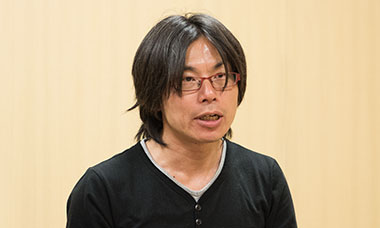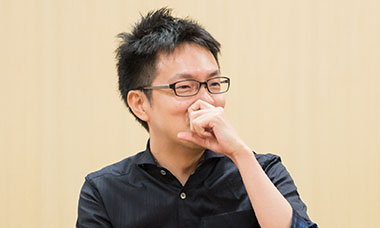So I think that a big feature of this game is that you decided to make three separate storylines, and involved Kibayashi-san to bring in a better quality story...
That’s right.
Was there any other aspect that you put a lot of focus on?
There were several, but one of those is the My Castle32 feature, which uses connectivity.32. My Castle: The player has the ability to create a unique “base” for themselves. They can build a village by adding buildings such as an armoury and various vendors. This is also where the characters in their unit live. Players can visit between chapters, to get equipped for the next battle or talk to unit members.
What’s that like?
As the name suggests, My Castle is your own castle that you can visit in between chapters. It allows players to lay out the town below the castle however they like. In addition to having conversations with the characters, players can also interact with other players and engage in battles. Maeda-san felt really strongly about putting this feature in, because we wanted players to have other fun things to do besides just the simulation game.

My Castle has a ridiculous amount of features too.
People on the staff said, “This could be a game in and of itself.”
It has enough content to be a game? Maeda-san, you had so much work making three games, why did you add in My Castle?
My Castle lets players experience living with the characters. We made it because we wanted players to really fall in love with all the characters.
And Maeda will do anything to make the characters more likable. He always tries to put in everything that will make players love the characters even more.
And because of that you made yet another game?
That’s right. Originally My Castle was just going to be used with StreetPass33, but using an internet connection, players can visit other towns, and have battles. This was something that came out of all of the ideas that Kibayashi-san gave us...33. StreetPass: A function that allows players to exchange data with people they pass on the street, as long as they have their system in Sleep Mode and wireless communication enabled.
Wait, so Kibayashi-san didn’t just write the story, he also gave you ideas?
Yes. While I was working with them, I just said whatever I felt like, even though there was probably no way they could do any of it, like, “You should do this!” or, “It would be really neat if you had something like this!”
Some of the ideas Kibayashi-san gave us were things that would have been difficult to do, but when we were telling him about My Castle, he said, “Don’t you think that even more people would play the game if they could communicate with other players some way besides StreetPass?”
So we decided to add the internet connection feature so that people who live in areas where they don’t get a lot of hits via StreetPass would be able to exchange game data with people, as long as they have an internet connection.
I’m really glad we did My Castle, though. Trying to get players deeply invested in the characters has been a big theme since Awakening, and I think that My Castle will help players get even more invested. And I feel like My Castle really works with the idea behind the title of “If”. (Editor’s note: Fire Emblem If is the game’s title in Japan) Of course there are a lot of “ifs” in the story.
So why did you decide to put the word “if” in the title?
When we were first thinking about this project, Yamagami-san was talking about history, and he said, “If that general had supported a different power during the Sengoku period, it would have changed history.”
That’s right. And then when we decided to make two separate packages, we kept thinking of different ‘what ifs?’, like “What if you ally with Kingdom A?” and “What if you ally with Kingdom B?” So personally, “if” was the only title I could think of. And when it came time to talk with everyone about titles, I said, “The only thing I can think of is ‘if’’,” Everyone said, “Yeah, it’s got to be ‘if’.” So we ended up naming the game Fire Emblem If.
Who thought of the titles for the two storylines, “White Nights Kingdom” and “Dark Nights Kingdom” for the Japanese release? (Editor’s note: These subtitles refer to the Japanese release only.)
Kibayashi-san. We can’t give out the official title of the third game yet, but it’s written in katakana instead of kanji34 which was also Kibayashi-san’s idea. When we first met him, he said, “What if we made the third game world something like this?”34. Katakana instead of kanji: Written Japanese consists of three kinds of characters: Kanji, Hiragana and Katakana. Kanji are ideographic characters, and Hiragana and Katakana are phonetic characters. Katakana characters are most often used for words that did not originate in Japan.
When you met up at the family restaurant?
Yes. (laughs)
I was really shocked. At first, it was about a war between two different nations, and we had a good idea of what those countries would be like, but we didn’t have any ideas for the third game yet. And then when we talked to Kibayashi-san, he asked, “Well, what about something like this?” He had so many ideas. And it fitted a katakana title perfectly.
I hadn’t even accepted the job offer at that point. (laughs)
You hadn’t?
But he was like, “Well, I’ll give you some ideas.” (laughs)
I was really impressed by how quickly he came up with ideas. I’m not the kind of person who can come up with things on the spot, so when people ask me, I’m always like, “Hold on, please.” (laughs)
That’s true. (laughs)
That is very true. (laughs) When I told him, “I want to package the two games separately,” he said, “Hold on, please.” (laughs)
(laugh)
It’s probably because you’re coming at it from completely opposite places. Kibayashi-san cut his teeth on serials for weekly magazines, and if he doesn’t reach a conclusion on the spot, he won’t meet his deadlines, whereas Maeda-san works in a field where he only needs to come up with ideas once every two or three years, so it’s okay for him to say, “Hold on, please.”
But when Maeda-san says, “Hold on, please,” it really means, “I’ll consider it, and probably go in that direction.” But when he says, “I see,” usually he won’t respond to it. That’s what I’ve learned after working with him for such a long time.
Oh, that’s true. I knew it was a catchphrase of his, but now I see that “I see” was a negative response.
I think it’s like this: if it was a line in manga, it would have an ellipsis after it. What I mean is, when the line is “I see…”, that means it’s a negative answer. But if there’s an exclamation mark after it…
That would be the kind of “I see!” that means they agree with what you’re saying.

And then when he says, “Hold on, please,”, there’s an ellipsis before it, like, “…hold on, please.” And that ellipsis indicates that it means, “I’ll consider it favourably.”
I see! (laughs) This will really help me in my future dealings with Maeda-san.
Thank you!
You’re so interesting, Maeda-san. (laughs) You’re a real character…
(laugh)
© 2024 Nintendo.